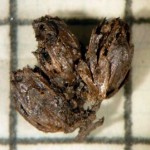 The unique 4,000-year-old cist burial found in Forteviot, Scotland, this summer has turned up an even greater surprise than the carvings on the massive capstone over the human remains on a bed of quartz pebbles and birch bark lattice with metal, wood, leather accessories: whole flowerheads.
The unique 4,000-year-old cist burial found in Forteviot, Scotland, this summer has turned up an even greater surprise than the carvings on the massive capstone over the human remains on a bed of quartz pebbles and birch bark lattice with metal, wood, leather accessories: whole flowerheads.
This is the first concrete evidence of pre-historic peoples intentionally burying someone with flowers. Pollen has been found in ancient graves thousands of years older than this one, but it could have gotten in there in a myriad ways, including in honey or mead sacrifices. These complete meadowsweet blossoms prove once and for all that our ancient ancestors used flowers in burials.
Dr Kenneth Brophy, from the University of Glasgow, said the flowers “don’t look very much. Just about three or four millimetres across.”
“But these are the first proof that people in the Bronze Age were actually placing flowers in with burials.”
The dark brown heads were found, along with a clump of organic material which archaeologists now say is the stems of the flowers.
The bunch had been placed by the head of the high-status individual known to have been buried in the grave.
Meadowsweet is a fragrant flower which has been used medicinally and for its fragrance for millennia. It’s mentioned as one of 50 ingredients of a beverage called “save” in Chaucer’s Knight’s Tale. A favorite of Queen Elizabeth I’s, it was most likely the flower strewn by Queen Gertrude over Ophelia’s grave when she says “Sweets to the sweet, farewell!” (Act V, Scene 1).
In more recent history, Italian Rafaele Piria first produced salicylic acid from meadowsweet and willow bark in 1838. When Bayer synthesized a related compound 60 years later, they called it aspirin after the botanical name for meadowsweet, Spiraea ulmaria.
Do not forget the name Felix Hoffmann. He was the inventor of the Aspirin. He synthetized this medicine…
Good to know. :hattip:
I think the Knight’s Tale reference has to do with a healing draught–“fermacies of herbes and eek save/They dronken, for they wolde hir lymes have.” I didn’t know what it was specifically, however. Interesting.
Yes indeed, meadowsweet was a common ingredient in medicinal brews. It might even have worked, what with the salicylic acid.